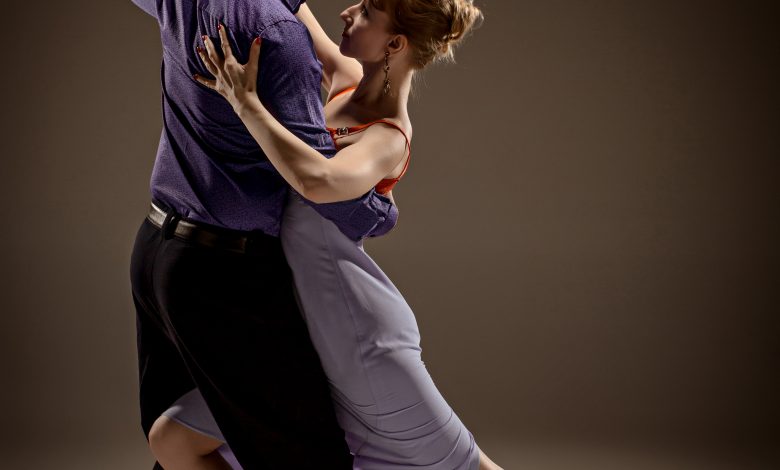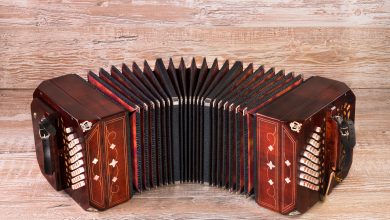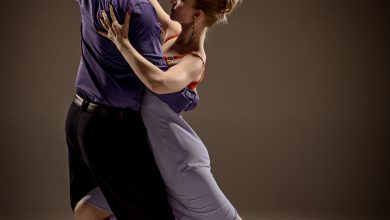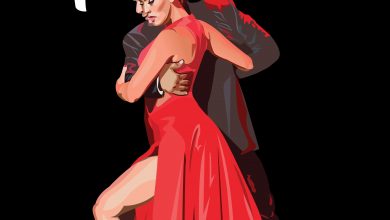Styles of Argentine Tango Dance

Tango Canyengue
The word Conyengue comes from the Kikongo language and translates as “melting with the music”. It was used to describe the tango rhythm at the time of the first ‘orquestas típicas’ (including bandoneón, violin and piano).
Tango Canyengue is a rhythmic style of tango that began in the early 1900s and continues to be popular to this day. It is the original roots style of tango and contains all the fundamental elements of traditional Argentine Tango. In Tango Canyengue the two dancers share one axis, dance in a closed embrace, and with the legs relaxed and slightly bent. Tango Canyengue uses body dissociation for leading, walking has firm ground contact, and a combination of on- and off-beat rhythm. Its major characteristics are its musicality and playfulness. Its rhythm is considered incisive, exciting, provocative.
Since the start of the this century, the Argentine Canyengue movement (Movimiento Cultural Canyengue Argentino), has revived the style. In its recent evolution, Tango Canyengue combines the original, grounded steps and close embrace with elegance, esthetics, and complicity between the two dance partners.
Leading exponents of Tango Canyengue:
Romolo Garcia (deceased)
El Negro Celso (deceased)
Rodolfo Cieri (deceased) and Maria Cieri
Luis Grondona
Marta Anton (deceased) and ‘El Gallego’ Manolo Salvador
Roxina Villegas and Adrian Griffero
Ernest Williams and Maricela Wilson
Omar and Monica Ocampo
Tango Orillero
Tango Orillero refers to the style of dance that developed away from the city centers, in the outskirts and suburbs where there was more available space on the dance floor and therefore freedom to move. The style is danced in an upright position and uses various embellishments including rapid foot moves, kicks, and recently some acrobatics
Tango Salon
Tango Salon does not refer to one specific way of dancing tango. It means tango as danced socially in the dance halls of Buenos Aires, Argentina. Tango Salon was danced throughout the Golden Era of Argentine Tango (1935–1952) when milongas were held in large dance venues and full tango orchestras performed. Tango Salon is characterized by slow, measured, and smoothly executed moves, never stepping against the line of dance, and respecting the space of other dancers on the floor. The emphasis in Tango Salon is on precision, smoothness, musicality, good navigation, and following the códigos (tango etiquette). The couple dances in closed embraces, opening slightly to make room for various figures and closing again for support and poise. The walk is probably the most important element, and dancers usually walk more than half of the time during a tango song.
One variation of Tango Salon is the Villa Urquiza style, named after the northern barrio of Buenos Aires where the clubs Sin Rumbo and Sunderland are located.
Milonguero Style
This is a closed embrace style given its name by Susana Miller in the 1990s. It came about because of crowded dance floors. Milonguero style is danced chest-to-chest, knees relaxed, back straight, with the partners leaning, or appearing to lean, slightly toward each other to allow space for the feet to move. The center line of the leader’s and follower’s backs are directly in front of each other, which requires each dancer to turn their head to their left slightly to find space over their partner’s right shoulder. The follower’s left arm reaches up over the leader’s shoulder without resting any body weight on the leader’s shoulder. The leader’s left hand and the follower’s right hand clasp in the same way as other Argentine Tango styles, with elbows pointed down, with little or no pressure applied by the arms or hands. The leader’s right arm is held high across the follower’s shoulder blades to help facilitate the upper chest connection, to avoid pulling the follower’s lower torso and hips in toward the leader, allowing more flexibility of movement in the mid and lower spine and better extension of the follower’s legs. With followers that are not tall enough to place their head over the leader’s shoulder, it is recommended that the follower’s head be turned to the right and touch the left side of the head to the leader’s chest, and the follower’s left arm may wrap around the outside right arm It is not recommended for a leader to dance Milonguero style with a follower that is too tall for the leader to see over the follower’s shoulder since it would be difficult to navigate around the dance floor.
Tango Nuevo
Starting in the 1990s in Buenos Aires, Argentina, the Tango Investigation Group (later called the Cosmotango organization) founded by Gustavo Naveira and Fabián Salas applied the principles of dance kinesiology from modern dance to analyze the physics of movement in Argentine Tango. Taking what they learned from this analysis they then began to explore all the possibilities of movement within the framework of Argentine Tango. From the work of these founders of the Tango Nuevo movement, there was a shift in all styles of tango away from teaching what to dance toward teaching how to dance.
Though often referred to as a tango style outside of Argentina, Tango Nuevo is not considered a style of dancing tango by the founders of the movement. It refers only to the method of analysis and teaching developed through the application of the principles of dance kinesiology to Argentine Tango.
Despite the insistence by the founders of the Tango Nuevo movement that it is not a single style, it has become an accepted term by many that it is a separate and distinct style of tango.
Tango Traditional
A very pure and early form of tango.
Tango con Corte y Quebrada (Cuts and Breaks)
Tango which adds cortes and quebradas (cuts and breaks).
Tango de Fantasía
This style mostly evolved in the 1940s and 1950s. The term Tango de Fantasía refers to music, dance, and dresses. it tries to describe a tango form different from the traditional one. Dancers added little sits and fast footwork – doing fantasies, as some people said. The related men’s suit with a white border is named Traje de Fantasía. In music, Osmar Héctor Maderna’s was referred to as Tango de Fantasía due to his arrangements which included fancy solos.
Show Tango
Show Tango, and Tango de Escenario (stage tango) is a more theatrical form of Argentine tango developed to suit the stage.
Show Tango routines includes embellishments, acrobatics, and solo moves that would be impractical on a social dance floor. Stage tango can be at least partially improvised, but in order for the choreography to fit the stage, some parts have to be rehearsed as a set routine.
Stage Tango still has to be led like it is led in other Tango styles. Otherwise the couple is missing the main ingredient of the dance – the typical intimate connection; this connection becomes visible only when the leader and follower enter their roles – whether the show is choreographed or not.
Stage Tango should not be confused with Tango de Fantasia or tango Acrobatico, which is a particular style of tango that is only suitable for stage dancing.



